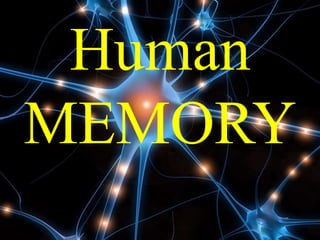
Human Memory
- 1. Human MEMORY
- 2. Let’s define memory… •is an ability to store, retain, and recall information and experiences. •is our ability to encode, store, retain and subsequently recall information and past experiences in the human brain.
- 3. TYPES OF MEMORY • Memory actually takes many • different forms. We know that • when we store a memory, • we are storing information. But, • what that information is and • how long we retain it determines • what type of memory it is. • The biggest categories of memory • are short-term memory (or working memory) and long-term memory, based on the amount of time the memory is stored.
- 5. Storage: Retaining Information Storage is at the heart of memory. Three stores of memory are shown below: Sensory Memory Working Memory Long-term Memory Encoding RetrievalEncoding Events Retrieval
- 6. *Sensory Memory -is the shortest-term element of memory. -The ability to look at an item for a second and then remember what it looked like. -It is processed approximately 200-500 milliseconds after an item is perceived.
- 7. Sensory Memories Iconic 0.5 sec. long Echoic 3-4 sec. long Hepatic < 1 sec. long The duration of sensory memory varies for the different senses.
- 9. *Short-term Memory (Working Memory) • Short-term or working memory is the brief time of keeping something in mind before dismissing it or pushing it into long- term memory. The hippocampus and subiculum store short- term memories.
- 10. Chunking F-B-I-T-W-A-C-I-A-I-B-M The capacity of the working memory may be increased by “chunking.” FBI TWA CIA IBM 4 chunks
- 11. Duration Peterson and Peterson (1959) measured the duration of working memory by manipulating rehearsal. CH?? The duration of the working memory is about 20 sec. CHJ MKT HIJ 547 547 544 541 …
- 13. *Long-Term Memory -Is the ability to store more information for long periods of time (life times) like phone numbers, names and address’ from when we were kids. -long-term memory can store much larger quantities of information for potentially unlimited duration (sometimes a whole life span). Its capacity is immeasurably large. - Long-term memory is often divided into two further main types: explicit (or declarative) memory and implicit (or procedural) memory.
- 14. Explicit (declarative) memory (facts): factual knowledge & personal experiences Types: > episodic memory >semantic memory Implicit (procedural) Memory (skills): Long-term memories of conditioned responses and learned skills, e.g., driving Types of Long-Term Memory
- 15. 1. Declarative/explicit memory (“knowing what”) refers to those memories that can be consciously recalled. >It is sometimes called explicit memory, since it consists of information that is explicitly stored and retrieved, although it is more properly a subset of explicit memory. >Declarative memory can be further sub-divided into episodic memory and semantic memory.
- 16. 1.1 Episodic Memory > represents our memory of experiences and specific events in time in a serial form, from which we can reconstruct the actual events. Personal experiences linked with specific times and places serial memory of events
- 17. 1.2 Semantic Memory >on the other hand, is a more structured record of facts, meanings, concepts and knowledge about the external world that can be described and applied.. Impersonal facts and everyday knowledge – structured memory of facts, concepts, skills
- 18. 2. Procedural memory (“knowing how”) >is the unconscious memory of skills and how to do things, particularly the use of objects or movements of the body, such as playing a guitar or riding a bike. Procedural memory is sometimes referred to as implicit memory, because previous experiences and conscious awareness of these previous experiences,
- 20. Memory Retrieval Once information has been encoded and stored in memory, it must be retrieved in order to be used. There are four basic ways in which information can be pulled from long-term memory • Recall • Recollection • Recognition • Relearning
- 21. Memory Recall/Retrieval *Retrieval, recall or recollection (calling back the stored information in response to some cue for use in a process or activity) previously encoded and stored in the brain. *During recall, the brain "replays" a pattern of neural activity that was originally generated in response to a particular event,
- 22. Why Do We Forget? Five Key Theories • Decay • Interference • Motivated Forgetting • Encoding Failure • Retrieval Failure
- 23. Five Theories of Forgetting (Continued) 1. Decay Theory: memory degrades with time 2. Interference Theory: one memory competes (interferes) with another –Retroactive Interference (new information interferes with old) –Proactive Interference (old information interferes with new)
- 24. 3. Motivated Forgetting: motivation to forget unpleasant, painful, threatening, or embarrassing memories 4. Encoding Failure: information in STM is not encoded in LTM 5. Retrieval Failure: memories stored in LTM are momentarily inaccessible (tip-of-the- tongue phenomenon) Five Theories of Forgetting (Continued)
- 25. Forgetting: Memory Failure • prospective memory – remembering to do something in the future content – remembering what to do timing – remembering when to do it – absentmindedness • amnesia – anterograde amnesia inability to store new information and events – retrograde amnesia inability to retrieve past information and events >age factor >brain injury etc…
- 26. THE END
